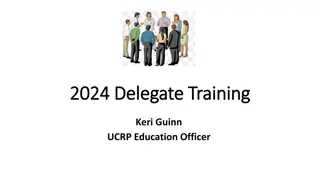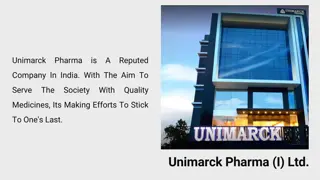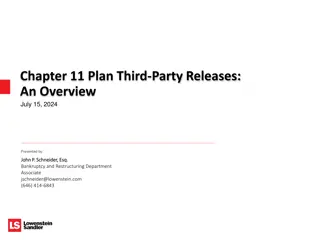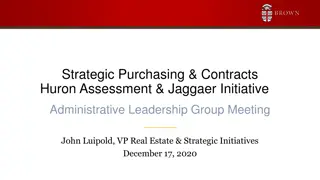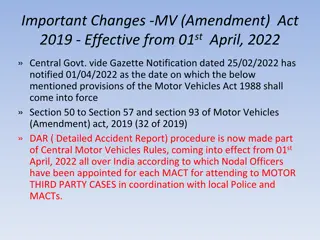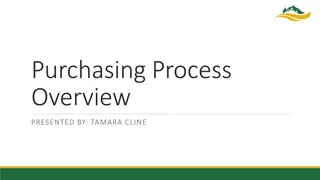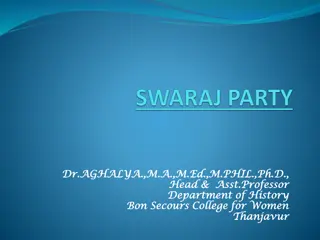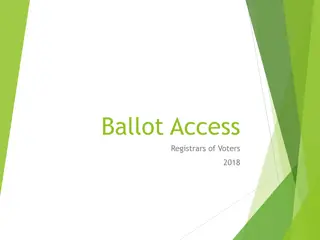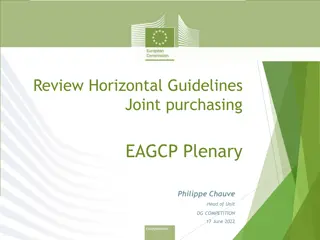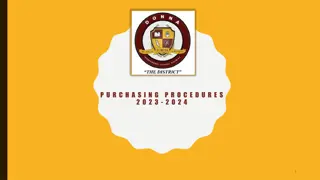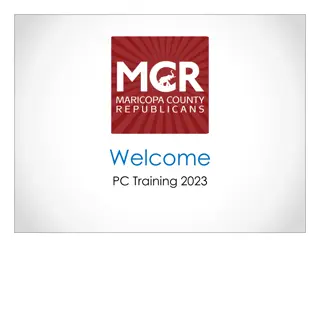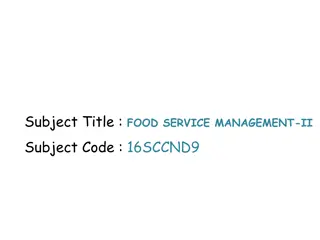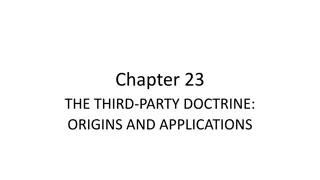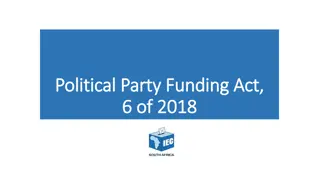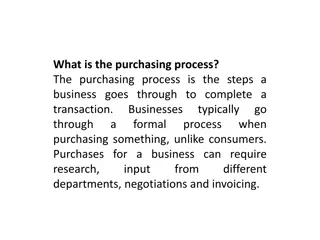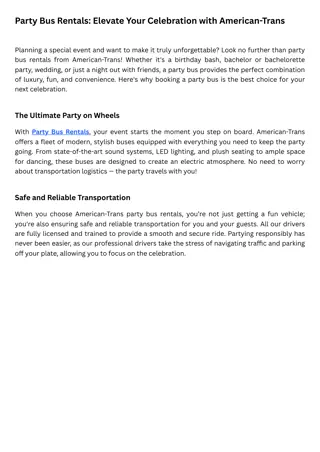Role of Third-Party Standards in Sustainable Purchasing
Sustainable purchasing relies on third-party standards and ecolabels to ensure products meet environmental criteria. ASTM International is a key organization developing voluntary consensus standards for various industries, including bioenergy and industrial chemicals from biomass.
Download Presentation

Please find below an Image/Link to download the presentation.
The content on the website is provided AS IS for your information and personal use only. It may not be sold, licensed, or shared on other websites without obtaining consent from the author.If you encounter any issues during the download, it is possible that the publisher has removed the file from their server.
You are allowed to download the files provided on this website for personal or commercial use, subject to the condition that they are used lawfully. All files are the property of their respective owners.
The content on the website is provided AS IS for your information and personal use only. It may not be sold, licensed, or shared on other websites without obtaining consent from the author.
E N D
Presentation Transcript
1 BACKGROUND: SUSTAINABLE PURCHASING: ROLE OF THIRD-PARTY STANDARDS AND ECOLABELS Biobased Stakeholder s Dialogue July 7, 2016
2 Table of Contents ASTM International Slides 3 - 9 ISO International Standard Organization Slide 10 ANSI American National Standards Institute Slide 11 Federal Trade Commission Green Guides Slides 12-18 NTTAA - National Technology Transfer and Accountability Act - Slide 19 Office of Management and Budget - Circular A-119 Slides 20-24 Executive Order 13693 Slides 25-28 Executive Order 13693 Implementing Instructions Slides 29-30 EPA's Draft Guidelines for Environmental Performance Standards and Ecolabels for Voluntary Use in Federal Procurement - Slides 31-32 EPA's Interim Recommendations of Specifications, Standards and Ecolabels Slides 33-39 SPLC Sustainable Purchasing Leadership Council Slides 40-42 U.S. Green Building Council LEED Slide 43
3 ASTM International ASTM International is one of the largest voluntary standards developing organizations in the world. It is a not-for-profit organization that provides a forum for the development and publication of international voluntary consensus standards for materials, products, systems and services. It has more than 30,000 volunteer members composed of technical experts and business professionals representing 140 countries that develop technical documents that are the basis of manufacturing, management, procurement, codes and regulations for dozens of industry sectors. ASTM volunteer members belong to one or more standards-writing committees, each of which covers a subject area. These committees have developed more than 12,000 ASTM standards. Three committees of interest E48 Committee on Bioenergy and Industrial Chemicals from Biomass E60 Committee on Sustainability E62 Committee on Industrial Biotechnology D20 Committee on Plastics
4 ASTM International E48 Committee The scope of E48 encompasses the promotion of knowledge and the development of standards for bioenergy and industrial chemicals from biomass. The focus of the committee shall be on bioenergy and industrial chemicals from biomass, from characterization through manufacturing. The work of this Committee will be coordinated with other ASTM Committees and other organizations having mutual interests. Example of current Committee work: WK27810 - New Practice for ASSESSING RELATIVE SUSTAINABILITY INVOLVING ENERGY OR INDUSTRIAL CHEMICALS FROM BIOMASS This document will include concepts, definitions and considerations that are relevant to assessment of relative sustainability yet are still lacking in the market place. Note that this work item will not endeavor to provide a comprehensive list of indicators of sustainability. Rather it will aim to provide a framework and guidance for developing standard assessments for consistent and comparable analysis. One goal is to lay out standard assessment guidelines and principles that could be used in the creation and evaluation of sustainability that lead to more sustainable outcomes. These could also be used to identify certification schemes and standards that could be misused to create inappropriate barriers to trade.
5 ASTM International E60 Committee on Sustainability Scope: The acquisition, promotion, and dissemination of knowledge, stimulation of research and the development of standards relating to sustainability and sustainable development. The committee shall include environmental, social, economic, and other issues relating to sustainability. This committee shall support and serve as a resource for other ASTM committees in their activities that include sustainability issues. This support may include dissemination of specific requests for standards throughout ASTM's existing committee base, as well as the maintenance of appropriate liaison relationships internal and external) related to this subject area. The committee will not duplicate the efforts of existing ASTM technical committees. The work of this committee will be coordinated with other ASTM committees and other organizations having mutual interest . The E60 Committee currently has subcommittees on: Buildings and Construction Hospitality Water Conservation and Use Sustainable Manufacturing General Sustainability Standards The E60 Committee also has two U.S. technical advisory groups (TAGS) to provide input to two international standards ISO TC59/SC17 - Sustainability in buildings and civil engineering works ISO PC 277 - Sustainable Purchasing
6 ASTM International Examples of E60 Committee Standards and Guides: ASTM E1971Standard Guide for Stewardship for the Cleaning of Commercial and Institutional Buildings This guide provides a basic reference for the development and preservation of a building environment that is considered safe and healthy for occupants, while reducing the stress on the overall environment as a result of routine maintenance. ASTM E2986-15 Standard Guide for Evaluation of Environmental Aspects of Sustainability of Manufacturing Processes This guide provides guidance to develop manufacturer-specific procedures for evaluating the environmental sustainability performance of manufacturing processes. Examples of Current E60 Committee Work: ASTM WK23356. New Practice for Development of Product Category Rules for Use in Development of Environmental Declarations for Building Products and Systems 1.1 This practice is for the development of consistent product category rules (PCR) that can be used by Type III environmental declarations program operators to develop business-to-business (cradle-to-gate) and business-to-consumer Type III environmental product declarations (EPD) for building products and systems. Product category rules provide a set of specific rules, requirements, and guidelines for developing EPD and specify the underlying requirements of the life-cycle assessment (LCA). 1.2 Only environmental aspects of sustainability are addressed in this practice.
7 ASTM International Examples of Current E60 Committee Work: ASTM WK49400 New Guide for The Development of Multi-Attribute Sustainability Standards for Building Products This standard establishes the principles and procedures for developing multi-attribute sustainability standards for building products. A multi-attribute sustainability standard identifies and incorporates a broad range of objective social, economic and environmental criteria throughout all phases of a products life cycle and establishes minimum thresholds for conformance as relevant to a product category. ASTM WK35705 New Guide for Sustainability Characterization of Manufacturing Processes The primary purpose of the guide is to define the methodology and measurement framework for improving the sustainability of manufacturing processes. The current use of ad-hoc methods to informally describe sustainability of manufacturing processes creates inefficiencies/disparities and hinders the ability of manufacturers to effectively evaluate the sustainability performance of its manufacturing processes. ASTM WK30419 New Guide for the Use of Agricultural Fiber in Construction This standard provides guidance for the use of agricultural fiber in building products. There is a great range of agricultural products in various stages of development for a great range of building products. This guide primarily addresses the use of the residues of food production, such as straw and seed hulls, but also includes the use of plants or plant parts grown specifically for their utility, such as hemp and bamboo. This guide explicitly does not cover the use of wood or other forest products, which are covered by many other standards. ASTM WK53012 1.1 This standard is a compilation of definitions of terms related to sustainability. 1.2 When a term is used in an ASTM document for which Committee E60 is responsible, it is included herein only when judged, after review by Subcommittee E60.80, to be a generally usable term. 1.3 Definitions of terms specific to a particular subcommittee will appear in that subcommittee terminology standard and will supersede any definitions of identical terms in this standard.
8 ASTM International E62 Committee on Industrial Biotechnology Scope: The development of standardized nomenclature and definitions of terms, recommended practices, guides, test methods, specifications, and performance standards for industrial biotechnology from raw materials to end products. The committee will encourage research in this field and sponsor symposia, workshops, and publications to facilitate the development of such standards. This committee shall support and serve as a resource for other ASTM committees in their activities that include industrial biotechnology issues. This support may include dissemination of specific requests for standards throughout ASTM's existing committee base, as well as the maintenance of appropriate liaison relationships (internal and external) related to this subject area. The committee will not duplicate the efforts of existing ASTM technical committees. The work of this committee will be coordinated with other ASTM committees and other organizations having mutual interest. Current Committee Work WK54849- New Terminology for Industrial Biotechnology 1.1 This terminology is a repository for the terms, and their standardized definitions, as relates to the technical standards generated by Committee E62 on Industrial Biotechnology. The meanings and explanations of the technical terms have been written for both the non-expert and the expert user. 1.2 At a minimum, this terminology is updated annually (at a time corresponding to the publication of the Annual Book of ASTM Standards containing this terminology standard) to include editorially any terms approved in the committees technical standards. 1.3 This standard does not purport to address all of the safety concerns, if any, associated with its use. It is the responsibility of the user of this standard to establish appropriate safety and health practices and to determine the applicability of regulatory limitations prior to use.
9 ASTM International D20 - Committee on Plastics Scope The development of test methods, specifications, recommended practices, nomenclature, definitions, and the stimulation of research relating to plastics, their raw materials, components, and compounding ingredients, and to finished products made from plastics such as sheets, rods, tubes, pipes, cellular materials, and molded or fabricated articles. Standard of Interest: D6866-12 - Standard Test Methods for Determining the Biobased Content of Solid, Liquid, and Gaseous Samples Using Radiocarbon Analysis
10 ISO International Standard Organization ISO is an independent, non-governmental international organization with a membership of 162 national standards bodies. Through its members, it brings together experts to share knowledge and develop voluntary, consensus-based, market relevant International Standards that support innovation and provide solutions to global challenges. Standards of interest: ISO 14040 Environmental management -- Life cycle assessment -- Principles and framework ISO 14025 - Environmental labels and declarations -- Type III environmental declarations -- Principles and procedures ISO 14020 - Environmental Labels and Declarations - General Principles ISO 14024 - : Environmental Labels and Declarations - Type I Environmental Labelling - Principles and Procedures ISO PC 277 - Sustainable Purchasing (under development)
11 ANSI American National Standards Institute ANSI has served in its capacity as administrator and coordinator of the United States private sector voluntary standardization system for more than 90 years. ANSI facilitates the development of American National Standards (ANS) by accrediting the procedures of standards developing organizations (SDOs). These groups work cooperatively to develop voluntary national consensus standards. Accreditation by ANSI signifies that the procedures used by the standards body in connection with the development of American National Standards meet the Institute s essential requirements for openness, balance, consensus and due process. Examples of ANSI-accredited standards NSF 140 Sustainability Assessment for Carpet Green Seal GS-42 Standard for Commercial and Institutional Cleaning ANSI/BIFMA e.3 Furniture Sustainability Standard
12 Federal Trade Commission Green Guides The Federal Trade Commission s (FTC) Guides for the Use of Environmental Marketing Claims ( Environmental Guides or Green Guides ) were issued to help marketers ensure that the claims they are making are true and substantiated. The Green Guides were issued in 1992 and last updated in 2012. The guidance they provide includes: (1) general principles that apply to all environmental marketing claims; (2) how consumers are likely to interpret particular claims and how marketers can substantiate these claims; and (3) how marketers can qualify their claims to avoid deceiving consumers.
13 Federal Trade Commission Green Guides 260.6 Certifications and seals of approval. (a) It is deceptive to misrepresent, directly or by implication, that a product, package, or service has been endorsed or certified by an independent third party. (b) A marketer's use of the name, logo, or seal of approval of a third-party certifier or organization may be an endorsement, which should meet the criteria for endorsements provided in the FTC's Endorsement Guides, 16 CFR part 255, including Definitions ( 255.0), General Considerations ( 255.1), Expert Endorsements ( 255.3), Endorsements by Organizations ( 255.4), and Disclosure of Material Connections ( 255.5).44 44 The examples in this section assume that the certifiers' endorsements meet the criteria provided in the Expert Endorsements ( 255.3) and Endorsements by Organizations ( 255.4) sections of the Endorsement Guides. (c) Third-party certification does not eliminate a marketer's obligation to ensure that it has substantiation for all claims reasonably communicated by the certification. (d) A marketer's use of an environmental certification or seal of approval likely conveys that the product offers a general environmental benefit (see 260.4) if the certification or seal does not convey the basis for the certification or seal, either through the name or some other means. Because it is highly unlikely that marketers can substantiate general environmental benefit claims, marketers should not use environmental certifications or seals that do not convey the basis for the certification. (e) Marketers can qualify general environmental benefit claims conveyed by environmental certifications and seals of approval to prevent deception about the nature of the environmental benefit being asserted. To avoid deception, marketers should use clear and prominent qualifying language that clearly conveys that the certification or seal refers only to specific and limited benefits.
14 Federal Trade Commission Green Guides 260.6 Certifications and seals of approval. Example 1: An advertisement for paint features a GreenLogo seal and the statement GreenLogo for Environmental Excellence. This advertisement likely conveys that: (1) the GreenLogo seal is awarded by an independent, third-party certifier with appropriate expertise in evaluating the environmental attributes of paint; and (2) the product has far-reaching environmental benefits. If the paint manufacturer awarded the seal to its own product, and no independent, third- party certifier objectively evaluated the paint using independent standards, the claim would be deceptive. The claim would not be deceptive if the marketer accompanied the seal with clear and prominent language: (1) indicating that the marketer awarded the GreenLogo seal to its own product; and (2) clearly conveying that the award refers only to specific and limited benefits.
15 Federal Trade Commission Green Guides 260.6 Certifications and seals of approval. Example 2: A manufacturer advertises its product as certified by the American Institute of Degradable Materials. Because the advertisement does not mention that the American Institute of Degradable Materials ( AIDM ) is an industry trade association, the certification likely conveys that it was awarded by an independent certifier. To be certified, marketers must meet standards that have been developed and maintained by a voluntary consensus standard body.45 An independent auditor applies these standards objectively. This advertisement likely is not deceptive if the manufacturer complies with 260.8 of the Guides (Degradable Claims) because the certification is based on independently-developed and -maintained standards and an independent auditor applies the standards objectively. 45Voluntary consensus standard bodies are organizations which plan, develop, establish, or coordinate voluntary consensus standards using agreed-upon procedures. * * * A voluntary consensus standards body is defined by the following attributes: (i) Openness, (ii) balance of interest, (iii) due process, (iv) an appeals process, (v) consensus, which is defined as general agreement, but not necessarily unanimity, and includes a process for attempting to resolve objections by interested parties, as long as all comments have been fairly considered, each objector is advised of the disposition of his or her objection(s) and the reasons why, and the consensus members are given an opportunity to change their votes after reviewing the comments. Memorandum for Heads of Executive Departments and Agencies on Federal Participation in the Development and Use of Voluntary Consensus Assessment Activities, February 10, 1998, Circular No. A-119 Revised, Office of Management and Budget at http://www.whitehouse.gov/omb/circulars_a119.
16 Federal Trade Commission Green Guides 260.6 Certifications and seals of approval. Example 3: A product features a seal of approval from The Forest Products Industry Association, an industry certifier with appropriate expertise in evaluating the environmental attributes of paper products. Because it is clear from the certifier's name that the product has been certified by an industry certifier, the certification likely does not convey that it was awarded by an independent certifier. The use of the seal likely is not deceptive provided that the advertisement does not imply other deceptive claims. Example 4: A marketer's package features a seal of approval with the text Certified Non-Toxic. The seal is awarded by a certifier with appropriate expertise in evaluating ingredient safety and potential toxicity. It applies standards developed by a voluntary consensus standard body. Although non-industry members comprise a majority of the certifier's board, an industry veto could override any proposed changes to the standards. This certification likely conveys that the product is certified by an independent organization. This claim would be deceptive because industry members can veto any proposed changes to the standards.
17 Federal Trade Commission Green Guides 260.6 Certifications and seals of approval. Example 5: A marketer's industry sales brochure for overhead lighting features a seal with the text EcoFriendly Building Association to show that the marketer is a member of that organization. Although the lighting manufacturer is, in fact, a member, this association has not evaluated the environmental attributes of the marketer's product. This advertisement would be deceptive because it likely conveys that the EcoFriendly Building Association evaluated the product through testing or other objective standards. It also is likely to convey that the lighting has far-reaching environmental benefits. The use of the seal would not be deceptive if the manufacturer accompanies it with clear and prominent qualifying language: (1) indicating that the seal refers to the company's membership only and that the association did not evaluate the product's environmental attributes; and (2) limiting the general environmental benefit representations, both express and implied, to the particular product attributes for which the marketer has substantiation. For example, the marketer could state: Although we are a member of the EcoFriendly Building Association, it has not evaluated this product. Our lighting is made from 100 percent recycled metal and uses energy efficient LED technology . Example 6: A product label contains an environmental seal, either in the form of a globe icon or a globe icon with the text EarthSmart. EarthSmart is an independent, third-party certifier with appropriate expertise in evaluating chemical emissions of products. While the marketer meets EarthSmart's standards for reduced chemical emissions during product usage, the product has no other specific environmental benefits. Either seal likely conveys that the product has far-reaching environmental benefits, and that EarthSmart certified the product for all of these benefits. If the marketer cannot substantiate these claims, the use of the seal would be deceptive. The seal would not be deceptive if the marketer accompanied it with clear and prominent language clearly conveying that the certification refers only to specific and limited benefits. For example, the marketer could state next to the globe icon: EarthSmart certifies that this product meets EarthSmart standards for reduced chemical emissions during product usage. Alternatively, the claim would not be deceptive if the EarthSmart environmental seal itself stated: EarthSmart Certified for reduced chemical emissions during product usage .
18 Federal Trade Commission Green Guides 260.6 Certifications and seals of approval. Example 7: A one-quart bottle of window cleaner features a seal with the text Environment Approved, granted by an independent, third-party certifier with appropriate expertise. The certifier granted the seal after evaluating 35 environmental attributes. This seal likely conveys that the product has far- reaching environmental benefits and that Environment Approved certified the product for all of these benefits and therefore is likely deceptive. The seal would likely not be deceptive if the marketer accompanied it with clear and prominent language clearly conveying that the seal refers only to specific and limited benefits. For example, the seal could state: Virtually all products impact the environment. For details on which attributes we evaluated, go to [a Web site that discusses this product]. The referenced Web page provides a detailed summary of the examined environmental attributes. A reference to a Web site is appropriate because the additional information provided on the Web site is not necessary to prevent the advertisement from being misleading. As always, the marketer also should ensure that the advertisement does not imply other deceptive claims, and that the certifier's criteria are sufficiently rigorous to substantiate all material claims reasonably communicated by the certification. Example 8: Great Paper Company sells photocopy paper with packaging that has a seal of approval from the No Chlorine Products Association, a non-profit third-party association. Great Paper Company paid the No Chlorine Products Association a reasonable fee for the certification. Consumers would reasonably expect that marketers have to pay for certification. Therefore, there are no material connections between Great Paper Company and the No Chlorine Products Association. The claim would not be deceptive.
19 NTTAA - National Technology Transfer and Accountability Act The National Technology Transfer and Accountability Act (NTTAA) was signed into law by President Clinton on March 7, 1996. The Act mandates that all federal agencies use technical standards developed and adopted by voluntary consensus standards bodies, as opposed to using government-unique standards. The guidelines used by agencies to assess and report their conformity with the requirements of the Act are detailed in Office of Budget and Management (OMB) Circular A-119. The Circular A-119 establishes the National Institute of Standards and Technology (NIST) as the agency responsible for coordinating conformity assessment activities, and requires NIST to report annually to OMB on the progress that federal agencies have made toward using voluntary standards. NTTAA states that federal agencies and departments shall: use technical standards developed or adopted by voluntary consensus standards bodies unless inconsistent with applicable law or otherwise impracticable ; and consult with voluntary, private sector, consensus standards bodies and shall, when such participation is in the public interest and is compatible with agency and departmental missions, authorities, priorities, and budget resources, with such bodies in the development of technical standards.
20 Office of Management and Budget - Circular A-119 Office of Managment and Budget (OMB) Circular A-119 provides guidance on Federal use of voluntary consensus standards and on conformity assessment. On January 27, 2016, OMB published its revised OMB Circular No. A-119, Federal Participation in the Development and Use of Voluntary Consensus Standards and in Conformity Assessment Activities. The revision process considered developments in regulation, standards and conformity assessment since the last revision in 1998, as well as U.S. trade agreements, developments in domestic and international regulatory, standards and conformity policies.
21 Office of Management and Budget Circular A-119 This Circular establishes policies to improve the internal management of the Executive Branch with respect to the U.S. Government s role in the development and use of standards and conformity assessment. Consistent the National Technology Transfer and Advancement Act of 1995 and U.S. Government executive orders, this Circular directs agencies to use standards developed or adopted by voluntary consensus standards bodies rather than government-unique standards, except where inconsistent with applicable law or otherwise impractical. This Circular provides guidance for agencies participating in the work of voluntary consensus standards bodies and describes procedures for satisfying the reporting requirements of the NTTAA. The policies in this Circular are intended to minimize the reliance by agencies on government unique standards.
22 Office of Management and Budget Circular A-119 How does this policy affect an agency's procurement authority? This policy does not preempt or restrict agencies authorities and responsibilities to identify the capabilities that they need to obtain through procurements. Rather, this policy establishes a preference for using a voluntary consensus standard, to the extent a suitable one exists, instead of pursuing an identified capability through reliance on a government-unique standard.
23 Office of Management and Budget Circular A-119 What is the Policy for Federal Participation in Standards Bodies? Consistent with Section 12(d)(2) of the NTTAA, agencies must consult with voluntary consensus standards bodies and must participate with such bodies in the development of standards when consultation and participation is in the public interest and is compatible with their missions, authorities, priorities, and budgetary resources. In voluntary consensus standards development processes, agency participation can be an important contribution to ensuring balance is achieved.
24 Office of Management and Budget - Circular A-119 The Circular does not preclude the use of standards other than voluntary consensus standards in rulemaking, procurement or other program activities in cases where: voluntary consensus standards do not exist or where use of existing voluntary consensus standards would be inconsistent with law or otherwise impractical, including where use of a voluntary consensus standard would not be as effective at meeting the agency s regulatory, procurement, or program needs. The Circular also recommends that the agency consider allowing the use of other standards as alternative means for complying with agency regulatory, procurement, or program requirements based on voluntary consensus standards where such other standards are also found to be suitable under the agency s analysis.
25 Executive Order 13693 Executive Order 13693 - Planning for Federal Sustainability in the Next Decade was signed on March 19, 2015. The EO s Sec 3 - Sustainability Goals for Agencies states the head of each agency shall, where life-cycle cost- effective, beginning in fiscal year 2016, unless otherwise specified: (3)(i) promote sustainable acquisition and procurement by ensuring that each of the following environmental performance and sustainability factors are included to the maximum extent practicable for all applicable procurements in the planning, award, and execution phases of the acquisition by:
26 Executive Order 13693 3(i)(i) meeting statutory mandates that require purchase preference for: (A) recycled content products designated by EPA; (B) energy and water efficient products and services, such as ENERGY STAR qualified and Federal Energy Management Program (FEMP)-designated products, identified by EPA and the Department of Energy (DOE); and (C) BioPreferred and biobased designated products designated by the United States Department of Agriculture; 3(i)(ii) purchasing sustainable products and services identified by EPA programs including: (A) Significant New Alternative Policy (SNAP) chemicals or other alternatives to ozone-depleting substances and high global warming potential hydrofluorocarbons, where feasible, as identified by SNAP; (B) WaterSense certified products and services (water efficient products); (C) Safer Choice labeled products (chemically intensive products that contain safer ingredients); and (D) SmartWay Transport partners and SmartWay products (fuel efficient products and services);
27 Executive Order 13693 3(i)(iii) purchasing environmentally preferable products or services that: (A) meet or exceed specifications, standards, or labels recommended by EPA that have been determined to assist agencies in meeting their needs and further advance sustainable procurement goals of this order; or (B) meet environmental performance criteria developed or adopted by voluntary consensus standards bodies consistent with section 12(d) of the National Technology Transfer and Advancement Act of 1995 (Public Law 104-113) and OMB Circular A-119;
28 Executive Order 13693 3(i)(iv) acting, as part of the implementation of planning requirements of section 14 of this order, until an agency achieves at least 95 percent compliance with the BioPreferred and biobased purchasing requirement in paragraph (i) of this subsection, to: (A) establish an annual target for the number of contracts to be awarded with BioPreferred and biobased criteria and dollar value of BioPreferred and biobased products to be delivered and reported under those contracts in the following fiscal year. To establish this target, agencies shall consider the dollar value of designated BioPreferred and biobased products reported in previous years, the specifications reviewed and revised for inclusion of BioPreferred and biobased products, and the number of applicable product and service contracts to be awarded, including construction, operations and maintenance, food services, vehicle maintenance, and janitorial services; and (B) ensure contractors submit timely annual reports of their BioPreferred and biobased purchases;
29 Executive Order 13693 Implementing Instructions To achieve sustainable acquisition and procurement goals under section 3(i), agencies must be consistent with statutory mandates for purchasing preference. Agencies shall then consider sustainable products and services identified by EPA and included under section 3(i)(ii), or voluntary specification, labels, or standards recommended by EPA as described in section 3(i)(iii)(A). Where no statutory mandates, EPA programs, or EPA recommended specifications, labels, or standards exist, agencies shall consider using voluntary standards as described under section 3(i)(iii)(B).
30 Executive Order 13693 Implementing Instructions EPA is responsible for recommending specifications, standards, or labels that designate environmentally preferable products and services through its Environmentally Preferable Purchasing (EPP) Program. Environmentally preferable products and services are those that have a lesser or reduced effect on human health and the environment when compared with competing products or services that serve the same purpose. In selecting product categories for review and recommendations, EPA shall prioritize those categories that represent the largest share of procurement spending across agencies and potential environmental impact. Within 90 days of these Instructions, EPA shall provide updated guidance on recommended specifications, labels, and standards that designate environmentally preferable products and services, in consultation with OMB and CEQ. This guidance and future interim and final recommendations by EPA shall be published by EPA on the EPP Program website and incorporated by GSA into the Green Procurement Compilation (GPC) in a timely manner.
31 EPA's Draft Guidelines for Environmental Performance Standards and Ecolabels for Voluntary Use in Federal Procurement In November 2013, EPA published Draft Guidelines for Environmental Performance Standards and Ecolabels for Voluntary Use in Federal Procurement EPA's goal in developing the Guidelines is to create a transparent, fair and consistent approach to recommending environmental performance standards and ecolabels to support the Agency's mission and federal sustainable acquisition mandates. Draft Guidelines consist of four sections: 1. Standards Development Process Are the procedures to develop, maintain, and update an environmental standard transparent? Do they allow for a balance of different stakeholder interests? Is there an appeals process for disputes? 2. Environmental Effectiveness of Standards Are the criteria in the standard/ecolabel that support environmental preferability measurable? Do they differentiate among products? Does the standard address key stages in the product lifecycle that may pose environmental and human health risks? 3. Conformity Assessment Are the procedures and practices by which products are assessed transparent? Are there provisions for independent verification that products meet the standard, if necessary? 4. Ecolabel Program Management Do the organizational and management practices provide for dispute resolution? Are the practices and fees transparent?" In December 2014, EPA issued a revised Section II of the Draft Guidelines EPA is conducting a pilot using the Draft EPA Guidelines to assess standards and ecolabels in three product categories: furniture; flooring; and paints, coatings and paint removers. Under the approach currently being piloted, key stakeholders and experts would convene to develop purchase category-specific criteria, based on the cross-sector guidelines. That criteria would be used to assess environmental standards and ecolabels that volunteer to be assessed. A list of product standards and ecolabels that meet the guidelines could be created, informing EPA s Recommendations per Section 3(i)(iii)A of Executive Order 13693.
32 EPA Guidelines Next Steps: EPA will complete the pilot assessments EPA will then finalize the Guidelines for Product Environmental Performance Standards and Ecolabels for Voluntary Use in Federal Procurement EPA will update the recommended standards and ecolabels In 2017 and beyond, EPA intends to: Disseminate the recommended standards and ecolabels. Integrate them in GSA s category management vehicles, contract writing systems, OMB scorecards, federal procurement data systems and training. Make the recommended standards and ecolabels standard operating procedure whereby federal purchasers will not have to figure out how to add them all into each procurement.
33 EPA's Interim Recommendations of Specifications, Standards and Ecolabels On March 19, 2015, EPA: Published Interim Recommended Specifications Standards and Ecolabels (last updated May 16, 2016) Provides recommended specifications, standards, and ecolabels for use in federal procurement to meet federal environmentally sustainable purchasing requirements in 7 categories: Cafeteria; Construction; Custodial; Electronics; Grounds Landscaping; Office; Operations Fleet Shipping Shop Categories are prioritized based on representing the largest share of [federal] procurement spending across Agencies and potential environmental impact.
34 EPA Interim Recommended Specifications and Ecolabels
35 EPA Interim Recommended Specifications and Ecolabels
36 EPA Interim Recommended Specifications and Ecolabels
37 EPA Interim Recommended Specifications and Ecolabels
38 EPA Interim Recommended Specifications and Ecolabels
39 EPA Interim Recommended Specifications and Ecolabels
40 SPLC Sustainable Purchasing Leadership Council The SPLC officially launched on July 23, 2013 as a non- profit organization whose stated mission is to support and recognize purchasing leadership that accelerates the transition to a prosperous and sustainable future. The SPLC envisions an organization of suppliers, purchasers, and public interest groups working together to provide guidance on sustainable purchasing and recognition of organizations including, companies, governments and academic institutions, that are leaders in sustainable purchasing. The U.S. General Services Administration, the U.S. Environmental Protection Agency (EPA), U.S. Department of Agriculture, and U.S. Department of Energy are all participants in this effort
41 SPLC Sustainable Purchasing Leadership Council The SPLC has developed guidance for purchasing in eight categories: Chemically Intensive Products [Cleaning and Sanitizing Products for Facilities Care, Landscaping and Grounds Maintenance, Paints and Coatings] Construction and Renovation [Construction and Renovation Materials, Furnishings, Space Leasing] Electricity Food and Beverages for Food Services [Food Service Operations and Food and Beverage Products] IT Hardware and Services [Data Centers, Imaging Equipment, Mobile Phones, Personal Computers, Televisions] Professional Services Transportation and Fuels [Fuels, Institutional Vehicle Fleets, Local Delivery Service, Long-Haul Transport, Travel] Wood and Agrifiber Products The SPLC intends to develop a rating system for recognizing leadership in sustainable purchasing patterned after the U.S. Green Building Council s LEED rating system for buildings.
42 SPLC Sustainable Purchasing Leadership Council The SPLC Guidance includes information on ecolabels and standards Some examples include: EPA Safer Choice GreenSeal (GS-11, 37, 40, 41, 43 and 53) UL 2759, 2760, 2796, 2794, 2795, 2777, 2784, 2809 Cradle to Cradle Certified Green Wise MPI Extreme Green Performance Standard GPS-1-12 and GPS-2-12 USDA BioPreferred UL GREENGUARD LEED EnergyStar EPEAT
43 U.S. Green Building Council - LEED The U.S. Green Building Council s Leadership in Energy and Environmental Design (LEED) is a third-party certification program for buildings Its recent revision (Version 4) contains specific requirements for use of ecolabels and standards for some types of building products. Some examples include: EPEAT EnergyStar GreenScreen v1.2Benchmark Cradle to Cradle Certified ANSI/BIFMA e3-2011Furniture Sustainability Standard GreenSeal (GS-42) ISO 14044 compliant Life-cycle assessments Environmental Product Declarations which conform to ISO 14025, 14040, 14044, and EN 15804 or ISO 21930 and have at least a cradle to gate scope. Sustainable Agriculture Network s Sustainable Agriculture Standard Forest Stewardship Council (FSC) or USGB-approved equivalent


